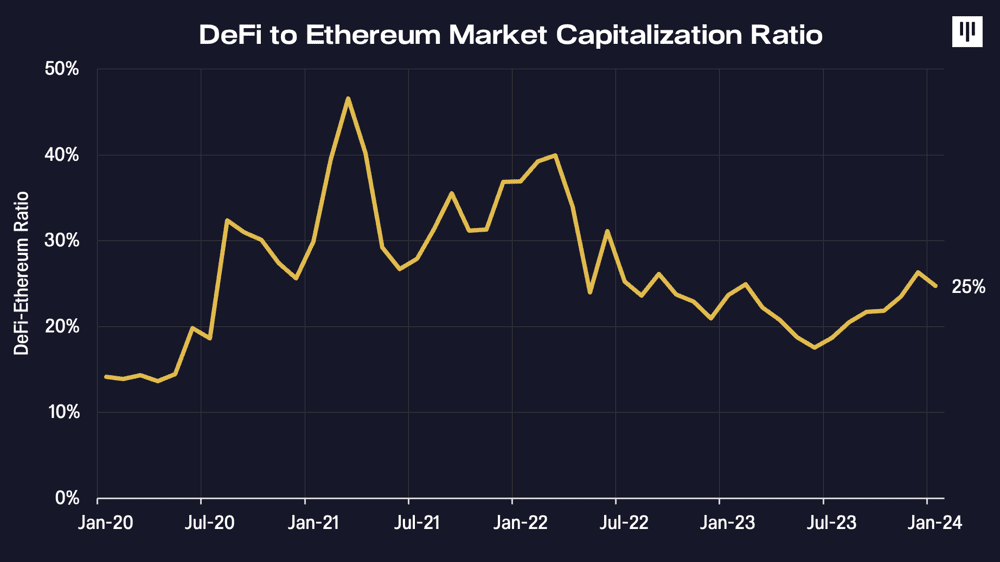The launch of so-called ‘synthetic dollar’ Ethena (USDe) took place on Monday, alongside a heavily-shilled points programme, labelled as a ‘Shard Campaign.’
So far, over $300 million has been deposited into Ethena, which promises an internet bond with a ‘real yield’ of 27% for users who stake USDe.
However, many are sceptical of the project’s sustainability, accusing Ethena of shortsightedness with respect to the source of the yield.
After all, this isn’t the first time a stable source of high-yields has been marketed to the masses.
The stablecoin (or ‘synthetic dollar‘) is backed by a delta-neutral position that balances a basket of staked ETH derivatives with ETH shorts on centralized exchanges (CEX).
The high yields that have been promised are achieved by adding together the native staking yield (around 5%) and the funding rates paid to shorts, which is currently high (over 20%) due to bullish overall market sentiment.
The trade is a common hedge that any user could set up manually. Ethena has packaged this trade along with a points programme to generate hype and is aiming to market itself to retail.
Although previous projects based on a similar trade failed to scale, Ethena’s head of growth is banking on using CEX liquidity rather than decentralized exchanges which are less popular.
Funding rate risk
In the case of a decrease in the relative demand for ETH long liquidity, the funding rate component falls, eating into Ethena’s high yield and potentially even threatening the USDe peg.
Ethena’s head of research, Conor Ryder, is keen to point out that data from the last three years shows negative funding rates on just 20% of days, with just 11% of negative days eclipsing the ETH staking yield. Furthermore, Ryder states that these periods rarely last long and act as an incentive for users to redeem USDe, even going as far as to say, “negative funding rates are a feature, rather than a bug of the system.”
However, studying historical data doesn’t take into account Ethena’s hundreds of millions of dollars worth of ETH shorts. Capitalizing on the funding rate arbitrage at such scale is expected to close the gap, driving down yields.
A $10 million insurance fund is in place to offset any periods of negative funding rates, although this also has its detractors who claim it would only serve to delay the inevitable.
Ethena investor and high-profile crypto pundit Cobie would instead prefer to see yields go negative as an incentive for users to redeem collateral and unwind the underlying positions.
In any case, a prolonged funding rate reversal should not result in a dramatic implosion, but instead a slow bleed-out as USDe depegs.
Other risks
Aside from funding rate risk, several other situations could cause problems for the stability of Ethena’s system.
The liquid staking derivative tokens that provide native proof of stake (PoS) yields are subject to a range of risks, including slashing, de-pegging, and hacks, any of which could see USDe’s backing falter.
Ethereum’s largest staking service finally regains stETH peg
Read more: Ethereum centralization is becoming a serious problem
The implosion of FTX shows how users can still lose everything on CEXs, despite them often being seen as a safe haven when compared to the Wild West of decentralized finance (DeFi). The fallout also showed how centralized platforms are able to cook their books while playing by their own rules.
The collateral for the ETH short positions won’t be held on the exchanges themselves, presumably to make the system more palatable for jaded traders. Instead, funds will be isolated from potential exchange blowups and will be entrusted to off-exchange custodial service providers such as Fireblocks and Copper. However, the use of crypto custodians is not without its own risk, as Celsius found out.
The next Luna?
Despite the difference in risk profile, many will be experiencing flashbacks to May 2022’s collapse of LUNA and the accompanying UST stablecoin, another widely-touted ‘stable’ source of high yields.
Ethena’s addition of a referral link-boosted points (or ‘Shards’) programmes has proven to be a TVL magnet in recent months, as crypto influencers ensure their followers help them achieve a high score in the hopes of receiving a hefty airdrop.
Here’s how crypto’s third largest stablecoin Terra (UST) collapsed
Read more: FTX customers to be repaid at $16,871 bitcoin prices
The inevitable looping of leverage as DeFi lenders spin up staked-USDe collateral pools is also likely to accelerate any future unwinding of USDe, as would any future extension of collateral to include re-staked ETH.
In the meantime, though, Ethena plans to wait for USDe to hit an equilibrium supply level before launching BTC collateral.
Sourced from cryptonews.net.









